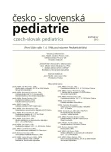ECMO (Extracorporeal Membrane Oxygenation) in the therapy of respiration and circulation failure in newborns and children
Authors:
V. Vobruba 1; O. Černá 1; D. Lorenčík 1; P. Pokorná 1; P. Srnský 1; V. Rohn 3; I. Vykydal 3; F. Mlejnský 3; J. Fichtl 3; G. Hodková 3; D. Nikitinský 3; J. Janota 4; T. Tláskal 5; T. Matějka 5; M. Rygl 6; prof. MUDr. Jan Bělohlávek, Ph.D. 2
Authors‘ workplace:
Klinika dětského a dorostového lékařství VFN a 1. LF UK, Praha
přednosta prof. MUDr. J. Zeman, DrSc.
1; II. interní klinika VFN a 1. LF UK, Praha
přednosta prof. MUDr. A. Linhart, DrSc.
2; II. chirurgická klinika kardiovaskulární chirurgie VFN a 1. LF UK, Praha
přednosta doc. MUDr. J. Lindner, CSc.
3; Novorozenecké oddělení, FTNsP, Praha
primář doc. MUDr. J. Janota, Ph. D.
4; Dětské kardiocentrum FN Motol, Praha
přednosta MUDr. J. Škovránek, CSc.
5; Klinika dětské chirurgie FN Motol, Praha
přednosta prof. MUDr. J. Šnajdauf, DrSc.
6
Published in:
Čes-slov Pediat 2012; 67 (Suppl 1): 6-12.
Category:
Original Papers
Overview
Extracorporeal membrane oxygenation (ECMO) is used for extracorporeal support of heart and/or lung function by means of a mechanical device. ECMO belongs to a complex of highly specialized care provided to patients with circulatory and/or ventilatory failures after all conventional therapeutic methods had failed.
We present an overview of ECMO and demonstrate its usefulness in newborns and children treated with this invasive rescue method at our center.
Key words:
ECMO, respiratory failure, circulatory failure, mechanical ventilation
Sources
1. Ventilation with lower tidal volumes as compared with traditional tidal volumes for acute lung injury and the acute respiratory distress syndrome. The Acute Respiratory Distress Syndrome Network. N Engl J Med 2000; 342 : 1301–1308.
2. Arnold JH, Anas NG, Luckett P, et al. High-frequency oscillatory ventilation in pediatric respiratory failure: A multicenter experience. Crit Care Med 2000; 28 : 3913–3919.
3. Willson DF. Effect of exogenous surfactant (calfactant) in pediatric acute lung injury: A randomized controlled trial (vol. 293, pg 470, 2005). JAMA – Journal of the American Medical Association 2005; 294 : 900–900.
4. DiCarlo JV, Pon S, Jefferson L, et al. Surfactant and pediatric acute lung injury – reply. JAMA – Journal of the American Medical Association 2005; 294 : 899–899.
5. Sokol J, Jacobs SE, Bohn D. Inhaled nitric oxide for acute hypoxic respiratory failure in children and adults: A meta-analysis. Anesthesia and Analgesia 2003; 97 : 989–998.
6. Curley MA, Thompson JE, Arnold JH. Effects of early and repeated prone positioning pediatric patients with acute lung injury (ALI). Crit Care Med 1999; 27: A125–A125.
7. Curley MA, Hibberd PL, Fineman LD, et al. Effect of prone positioning on clinical outcomes in children with acute lung injury: a randomized controlled trial. JAMA 2005; 294 : 229–237.
8. Flori HR, Glidden DV, Rutherford GW, et al. Pediatric acute lung injury: prospective evaluation of risk factors associated with mortality. Am J Respir Crit Care Med 2005; 171 : 995–1001.
9. Erickson S, Schibler A, Numa A, et al. Acute lung injury in pediatric intensive care in Australia and New Zealand: a prospective, multicenter, observational study. Pediatr Crit Care Med 2007; 8 : 317–323.
10. Zimmerman JJ, Akhtar SR, Caldwell E, et al. Incidence and outcomes of pediatric acute lung injury. Pediatrics 2009; 124 : 87–95.
11. Hill JD, O’Brien TG, Murray JJ, et al. Prolonged extracorporeal oxygenation for acute post-traumatic respiratory failure (shock-lung syndrome). Use of the Bramson membrane lung. N Engl J Med 1972; 286 : 629–634.
12. Barlett RH, Gazzaniga AB, Jefferies MR, et al. Extracorporeal membrane oxygenation (ECMO) cardiopulmonary support in infancy. Trans Am Soc Artif Intern Organs 1976; 22 : 80–93.
13. Van Meurs K, Lally KP, PeekG, et al. Extracorporeal Cardiopulmonary Support in Critical Care. 3rd ed. ELSO, 2005 : 1–273.
14. Zabrocki LA, Brogan TV, Statler KD. Extracorporeal membrane oxygenation for pediatric respiratory failure: Survival and predictors of mortality. Crit Care Med 2011; 39 : 364–370.
15. Schaible T, Hermle D, Loersch F, et al. A 20-year experience on neonatal extracorporeal membrane oxygenation in a referral center. Intens Care Med 2010; 36 : 1229–1234.
16. Reickert CA, Schreiner RJ, Bartlett RH, et al. Percutaneous access for venovenous extracorporeal life support in neonates. J Pediat Surg 1998; 33 : 365–369.
17. Muntean W. Coagulation and anticoagulation in extracorporeal membrane oxygenation. Artificial Organs 1999; 23 : 979–983.
18. Van Meurs K, Lally KP, Peek G, et al. Extracorporeal Cardiopulmonary Support in Critical Care. 3rd ed. ELSO, 2005, 1–371.
19. Moulton SL, Lynch FP, Cornish JD, et al. Carotid-artery reconstruction following neonatal extracorporeal membrane oxygenation. J Pediat Surg 1991; 26 : 794–799.
20. Karimova A, Brown K, Ridout D, et al. Neonatal extracorporeal membrane oxygenation: practice patterns and predictors of outcome in the UK. Arch Dis Child Fetal Neonatal Ed 2009; 94: F129–F132.
21. Massaro A, Rais-Bahrami K, Chang T, et al. Therapeutic hypothermia for neonatal encephalopathy and extracorporeal membrane oxygenation. J Pediatr 2010; 157 : 499–501.
22. Rajagopal SK, Almond CS, Laussen PC, et al. Extracorporeal membrane oxygenation for the support of infants, children, and young adults with acute myocarditis: a review of the Extracorporeal Life Support Organization registry. Crit Care Med 2010; 38 : 382–387.
23. Van Meurs K, Lally KP, Peek G, et al. Extracorporeal Cardiopulmonary Support in Critical Care. 3rd ed. ELSO, 2005 : 1–204.
Labels
Neonatology Paediatrics General practitioner for children and adolescentsArticle was published in
Czech-Slovak Pediatrics

2012 Issue Suppl 1
Most read in this issue
- Diagnosis and management of pediatric cataract
- Foreign body in the gastrointestinal tract – a case report and current diagnostic and therapeutic recommendations
- ECMO (Extracorporeal Membrane Oxygenation) in the therapy of respiration and circulation failure in newborns and children
- The folic acid and neural tube defects – from past to present
